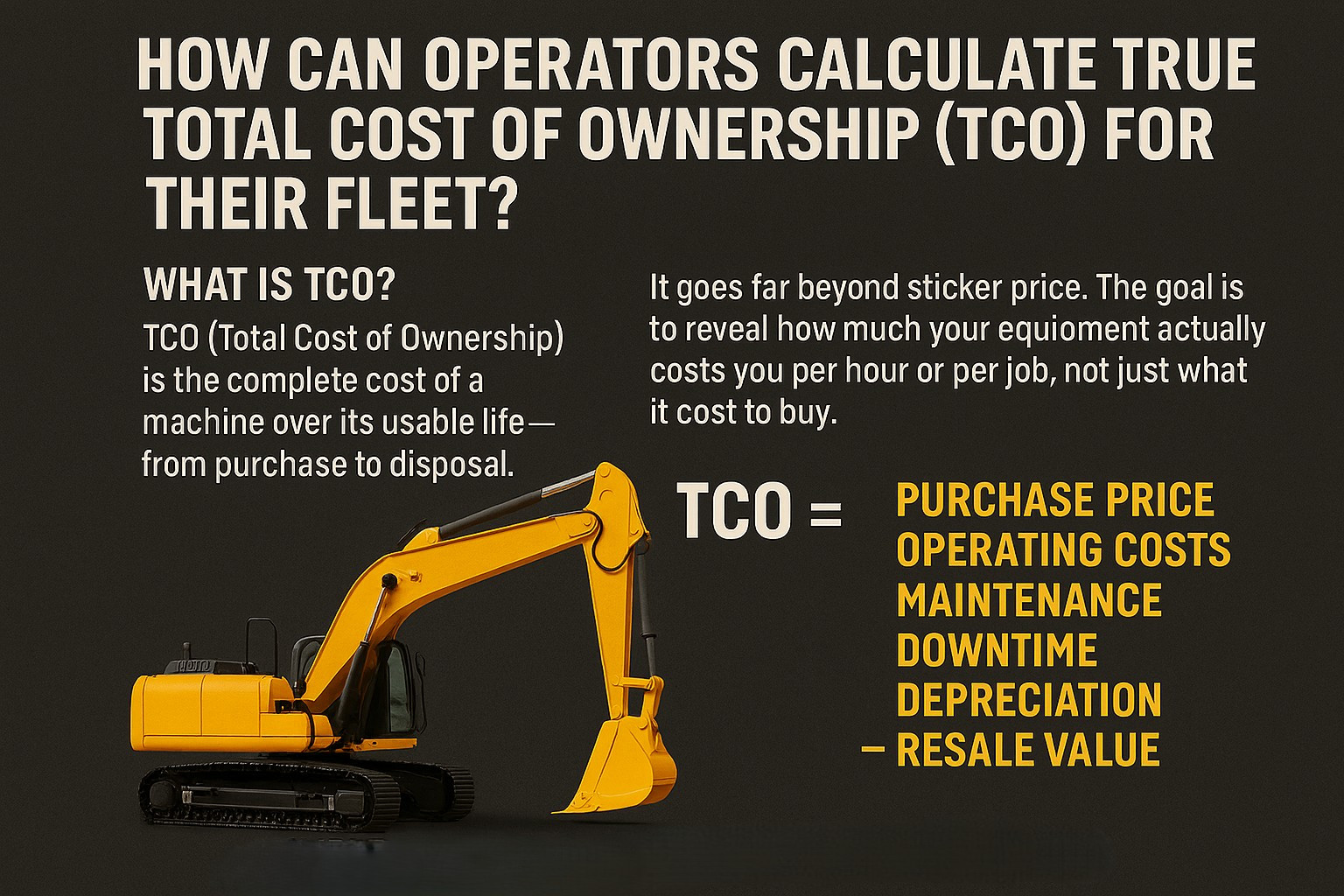The Dirt Desk - Q&A
How Can Operators Calculate True Total Cost of Ownership (TCO) for Their Fleet?
When it comes to running heavy equipment, most operators can tell you what they paid for a machine down to the dollar. But ask what it really costs them to own and operate it — fuel, maintenance, downtime, resale value, even operator training — and the answers start to get fuzzy.
That’s where Total Cost of Ownership (TCO) comes in. Understanding TCO can mean the difference between running a profitable operation and one that quietly bleeds cash. Let’s break it down.
What Is TCO?
TCO (Total Cost of Ownership) is the complete cost of a machine over its usable life — from purchase to disposal.
It goes far beyond sticker price. The goal is to reveal how much your equipment actually costs you per hour or per job, not just what it cost to buy.
TCO = Purchase Price + Operating Costs + Maintenance + Downtime + Depreciation – Resale Value
Simple formula — but the devil’s in the details.
The Core Costs That Make or Break Profitability
Let’s dig into the real-world numbers you need to track.
1. Acquisition Costs
This includes:
- Purchase price (or lease payments)
- Shipping and delivery
- Setup or attachments
- Financing interest
It’s the easiest part of the equation — but only a small piece of the pie.
2. Operating Costs
The daily grind. Everything it takes to run your machine:
- Fuel or energy (diesel, hybrid, electric)
- Fluids & filters
- Tires or tracks
- Operator wages
- Site logistics & transport
Fuel alone can account for 30–40% of lifetime ownership cost for diesel machines. That’s why newer, more efficient or hybrid units can pay off faster than they appear on paper.
3. Maintenance & Repairs
Preventive maintenance is one thing; unexpected downtime is another.
Include:
- Scheduled services (oil changes, inspections)
- Parts replacements
- Wear components
- Unplanned breakdowns
Tip: Use telematics data or a simple spreadsheet to log all maintenance costs. Over time, this gives you a realistic per-hour maintenance rate.
Many operators underestimate how quickly small fixes add up — especially if multiple machines age out at once.
4. Downtime Costs
This is the silent profit killer. Every day a machine sits idle — whether waiting for parts, weather, or a technician — it’s costing you revenue.
To calculate:
Downtime cost = (Average hourly revenue × Hours of downtime)
Even a few unexpected failures a year can shift your TCO significantly. Modern telematics systems can help predict failures and reduce unplanned downtime by up to 20%.
5. Depreciation
All machines lose value — but not at the same rate.
Track how your specific brand, model, and hour range perform on the used market. Some brands retain value longer due to reliability or demand.
Depreciation is typically 30–50% of total TCO, depending on resale conditions.
6. Resale or Disposal Value
When you sell or trade in your machine, this recovers part of your investment.
Make sure to:
- Maintain records (service history, hours)
- Keep the machine clean and updated
- Know seasonal trends in resale pricing (spring & early summer often bring higher prices)
A well-maintained unit can fetch 10–20% higher resale — a major difference over a fleet of multiple machines.
Putting It All Together: A Quick Example
Let’s look at a mid-size excavator:
|
Category |
Cost (CAD) |
|
Purchase price |
$300,000 |
|
Operating (fuel, fluids, etc.) |
$180,000 |
|
Maintenance |
$75,000 |
|
Downtime (estimated 200 hrs @ $200/hr loss) |
$40,000 |
|
Depreciation |
$100,000 |
|
Subtotal |
$695,000 |
|
Resale Value (after 5 years) |
–$120,000 |
|
Total Cost of Ownership (TCO) |
$575,000 |
|
Cost per hour (5,000 hours) |
$115/hr |
That $300K excavator? It’s really costing about $115 per operating hour once you factor everything in.
Why This Matters More Than Ever
With high fuel costs, tightening margins, and rising equipment prices, understanding TCO helps you:
- Set accurate bid rates — no more underpricing yourself.
- Decide whether to rent, lease, or buy.
- Plan replacement schedules before costs spike.
- Compare diesel vs hybrid vs electric options based on lifetime costs, not sticker shock.
Companies that track TCO consistently report 10–15% higher profit margins than those that don’t.
Tools and Tips for Tracking TCO
- Use telematics data (most modern machines include it) to log fuel burn, idle time, and maintenance alerts.
- Fleet management software like EquipmentWatch, VisionLink, or Tenna can automate cost-per-hour tracking.
- Don’t ignore downtime — even if it’s just weather or transport delays, it’s still lost productivity.
- Revisit your numbers quarterly. Costs fluctuate with fuel prices, inflation, and hours used.
The Bottom Line
Every piece of iron in your yard has a story — but the numbers tell the truth.
Knowing your true TCO means you can:
- Bid smarter
- Run leaner
- Invest wiser
- And keep your business strong, no matter what the market throws your way
At the end of the day, the best operators aren’t just great behind the controls — they’re sharp on the spreadsheets, too.

